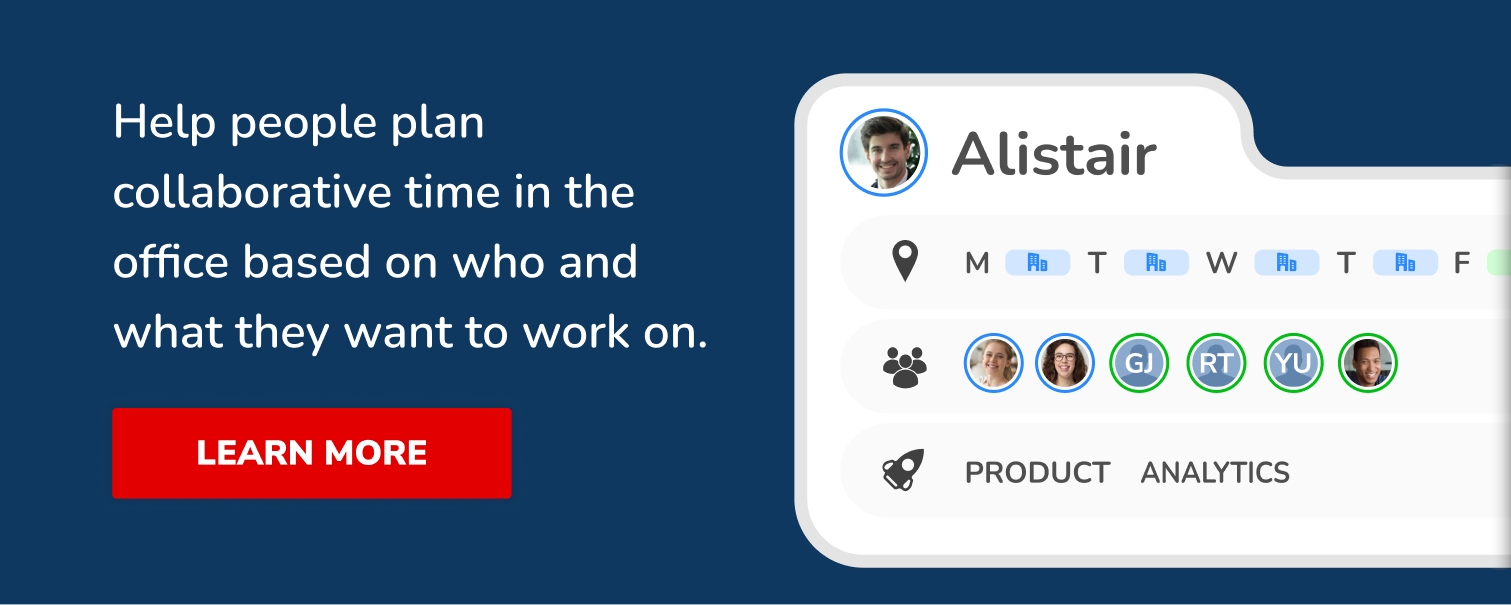The COVID-19 pandemic has dramatically reshaped the modern workplace, with many organisations embracing hybrid work models that blend remote and in-office work. As businesses navigate this new landscape, they face the challenge of managing a distributed workforce while maintaining productivity, collaboration, and employee satisfaction. One key aspect of this transition is the adoption of hybrid desk booking tools, which enable employees to reserve workspaces and manage their in-office schedules.
Hybrid work offers numerous benefits, such as increased flexibility, improved work-life balance, and reduced commute times. A study by Owl Labs found that 84% of workers believe a hybrid work model would make them happier, with 64% willing to take a pay cut to have a hybrid work arrangement. However, it also presents challenges, including a lack of visibility into employee attendance, potential for reduced collaboration, and difficulty in optimising office space utilisation. As organisations seek to strike a balance between remote work and in-office presence, it becomes crucial to implement strategies that encourage employees to spend time in the office while still maintaining the flexibility that hybrid work provides.
This article explores the role of hybrid desk booking tools in boosting in-office collaboration and productivity. By leveraging these tools effectively, organisations can create a dynamic and engaging workplace that adapts to the needs of a hybrid workforce. We will delve into the features and benefits of desk booking software, discuss strategies for increasing in-office attendance, and provide insights on how to successfully integrate hybrid work schedules. The goal is to help organisations navigate the complexities of hybrid work and create a thriving, collaborative work environment that benefits both employees and the company as a whole.
What are Hybrid Desk Booking Tools?
Hybrid desk booking tools are software solutions designed to help organisations manage their workspace in a flexible, hybrid work environment. These tools enable employees to reserve desks and other workspaces in advance, ensuring that they have a dedicated space to work when they come into the office. The core functions of hybrid desk booking tools include:
1. Desk Reservation: Employees can easily view available desks or zones and book them for specific dates and times, often through a user-friendly web interface.
2. Scheduling: Hybrid desk booking tools allow employees to plan their in-office days in advance, providing visibility to their colleagues and managers.
3. Workspace Analytics: These tools provide valuable data on workspace utilisation, occupancy rates, and employee attendance patterns, helping organisations optimise their office layout and resources.
By implementing hybrid desk booking tools, organisations can effectively manage their workspace, optimise resource utilisation, and support the needs of their hybrid workforce.
The Benefits of Hybrid Desk Booking Tools
Hybrid desk booking tools offer numerous benefits to organisations looking to optimise their workspace and support a hybrid workforce. By implementing these tools, companies can experience:
1. Enhanced Space Optimization: Desk booking software helps organisations reduce real estate costs by allowing them to adapt to fluctuating capacity needs. By understanding workspace usage patterns, companies can make informed decisions about office layout, desk allocation, and even downsizing or expanding their office space.
2. Improved Employee Experience: Hybrid desk booking tools offer employees choice and autonomy in their work arrangements. As Satya Nadella, CEO of Microsoft, stated in a recent interview, 'Hybrid work represents the biggest shift to how we work in our generation. And it will require a new operating model, spanning people, places, and processes’. By providing the flexibility to choose when and where they work, organisations can boost employee satisfaction and productivity. This autonomy is particularly valuable in a hybrid setting, where employees appreciate the ability to balance in-office and remote work.
3. Increased Visibility: With hybrid desk booking tools, managers gain a clear understanding of workspace usage and can track in-office attendance patterns. This visibility is crucial for managing a hybrid workforce, as it helps identify collaboration opportunities, monitor employee engagement, and ensure that teams have the necessary face-to-face interaction.

4. Data-Driven Decision Making: The analytics provided by hybrid desk booking tools enable organizations to make informed decisions about their workplace. By analysing usage trends, companies can identify peak occupancy times, underutilised areas, and opportunities for space optimization. This data-driven approach helps organisations adapt to the evolving needs of their hybrid workforce and make strategic changes to their office environment.
The benefits of hybrid desk booking tools extend beyond simple space management. By leveraging these tools effectively, organisations can create a more agile, responsive, and employee-centric workplace that supports the success of their hybrid workforce.
How to Leverage Desk Booking Tools for Increased In-Office Time

Hybrid desk booking tools are not just about managing workspace; they can also be powerful allies in encouraging employees to spend more time in the office. By leveraging these tools strategically, organisations can create a dynamic, collaborative workplace that entices employees to choose in-office work more frequently. Here are some key strategies to boost in-office attendance using desk booking software:
1. Team Collaboration Days: Designate specific days for teams or departments to work together in the office. By coordinating in-office presence, teams can foster collaboration, strengthen relationships, and tackle complex projects more effectively. Desk booking tools can facilitate this by allowing managers to block off clusters of desks for their teams on designated collaboration days. This approach ensures that team members have the opportunity to work side-by-side, share ideas, and build camaraderie. Tools like DuoMe’s Hybrid Desk Booking can automatically suggest good collaboration days based on who people work with.
2. "Neighbourhood" Booking: Encourage employees to reserve desks in close proximity to their colleagues or team members. By creating "neighbourhoods" or zones within the office, organisations can foster a sense of community and belonging. Desk booking tools that offer zones can make it easy for employees to locate and book desks near their peers. This proximity promotes spontaneous interactions, knowledge sharing, and a more vibrant office atmosphere.
3. Gamification and Incentives: Introduce gamification elements or incentives to reward employees who spend more time in the office. Desk booking tools can track individual office attendance, allowing organisations to create leaderboards, award points, or offer perks to those who frequently work on-site. These incentives can be tied to tangible rewards, such as gift cards, extra vacation days, or professional development opportunities. By making office attendance fun and rewarding, organisations can motivate employees to choose in-office work more often.
4. Highlight In-Office Events: Use desk booking tools to promote workshops, lunch-and-learns, social events, and other in-office activities. By showcasing the unique experiences and opportunities available on-site, organisations can create a sense of excitement and FOMO (fear of missing out) around office attendance. Desk booking software can be used to send targeted notifications about upcoming events to employees who have booked desks on specific days, encouraging them to participate and engage with their colleagues.
By implementing these strategies and leveraging the capabilities of hybrid desk booking tools, organisations can create a compelling case for in-office work. The key is to strike a balance between structure and flexibility, providing employees with the autonomy to choose their work location while also fostering a sense of community, collaboration, and engagement within the office environment. As organisations navigate the challenges of hybrid work, desk booking tools can be a valuable asset in shaping a workplace that adapts to the needs of a distributed workforce while still reaping the benefits of face-to-face interaction.
Additional Strategies to Increase Office Attendance
In addition to leveraging desk booking tools, organisations can implement various strategies to encourage employees to spend more time in the office. These strategies focus on making office days more valuable, creating a welcoming workplace environment, and addressing employee concerns. Here are some key approaches:
1. Making Low-Capacity Days Valuable: Organisations can boost attendance on typically low-capacity days, such as Mondays or Fridays, by offering targeted initiatives. This might include scheduling in-office training sessions, enabling entire teams to attend on these days, or even requiring employees to attend a certain number of low-capacity days each month. By making these days more purposeful and collaborative, organisations can distribute office attendance more evenly throughout the week.
Example: Your company notices that Fridays have the lowest office attendance. To address this, they implement "Learning Fridays," where they host a series of professional development workshops and team-building activities. Managers encourage their teams to attend these sessions together, fostering a sense of community and making Fridays more engaging and valuable.

2. Investing in a Welcoming Workplace: To entice employees to choose in-office work, organisations must create a comfortable, inviting, and well-equipped workspace. This includes offering amenities such as coffee, snacks, and ergonomic furniture. By investing in a pleasant office environment, companies can make the workplace feel like a destination rather than an obligation.
Example: revamping office space to include a variety of work zones, from collaborative areas with whiteboards and comfy seating to quiet focus rooms for individual work. Partner with a local café to provide healthy lunch options, making the office a more appealing place to spend time.
3. Emphasising the Value of Face-to-Face Interaction: While remote work has its advantages, it's essential to highlight the unique benefits of in-person collaboration. Face-to-face interactions are particularly valuable for activities such as mentorship, brainstorming, and building strong team relationships. By communicating the importance of these in-person experiences, organisations can motivate employees to prioritise office time.
Example: Launch a "Mentor Matchup" program, pairing junior employees with experienced colleagues for regular in-office mentoring sessions. By emphasising the value of face-to-face guidance and knowledge sharing, the company encourages both mentors and mentees to spend more time in the office, fostering personal growth and strong professional connections.
4. Addressing Employee Concerns: To effectively increase office attendance, organisations must understand and address the reasons behind employees' preference for remote work. Conducting surveys or focus groups can help identify concerns such as commute times, work-life balance, or health and safety issues. By actively listening to employee feedback and implementing solutions, companies can create a more inclusive and accommodating workplace that encourages in-office presence.
Example: Global Enterprises surveys its employees and discovers that many are hesitant to return to the office due to long commute times. In response, the company introduces a flexible work policy that allows employees to adjust their schedules to avoid peak traffic hours.
By combining these strategies with the effective use of hybrid desk booking tools, organisations can create a comprehensive approach to boosting in-office attendance. The key is to remain adaptable, responsive, and attuned to the needs of the workforce, continually refining and improving initiatives based on employee feedback and evolving workplace dynamics.
Conclusion
Hybrid desk booking tools play a crucial role in helping organisations navigate the complexities of the post-pandemic workplace. As businesses embrace hybrid work models, these tools provide a powerful solution for managing workspace, optimising office utilisation, and fostering collaboration among distributed teams.
By leveraging desk booking software strategically, organisations can encourage employees to spend more time in the office, reaping the benefits of face-to-face interaction while still maintaining the flexibility that hybrid work offers. From designating team collaboration days to gamifying office attendance, these tools enable companies to create a dynamic, engaging workplace that adapts to the needs of a hybrid workforce.
However, the success of a hybrid work environment extends beyond the implementation of desk booking tools alone. It requires a holistic approach that encompasses investment in a welcoming office space, open communication about hybrid schedules, and a commitment to addressing employee concerns. By combining these strategies with the effective use of desk booking software, organisations can strike the right balance between remote work and in-office presence.
As we move forward in this new era of work, it is clear that hybrid models are here to stay. By embracing the power of hybrid desk booking tools and adopting a proactive, employee-centric approach, organisations can create a thriving, collaborative workplace that drives productivity, innovation, and success in the years to come.
About Author
Graham Joyce is co-founder of DuoMe, a flexible working advocate and a frequent panellist/commentator on the issues of flexibility or hybrid working.







